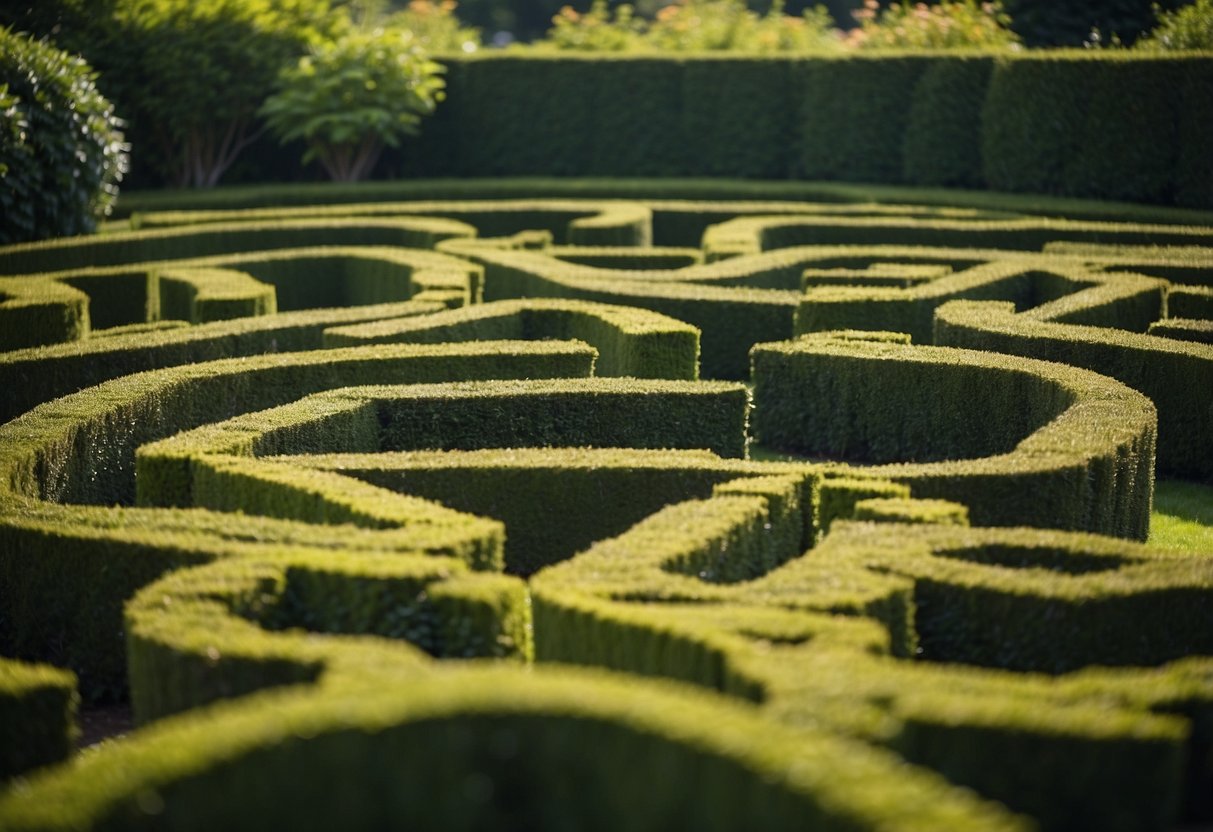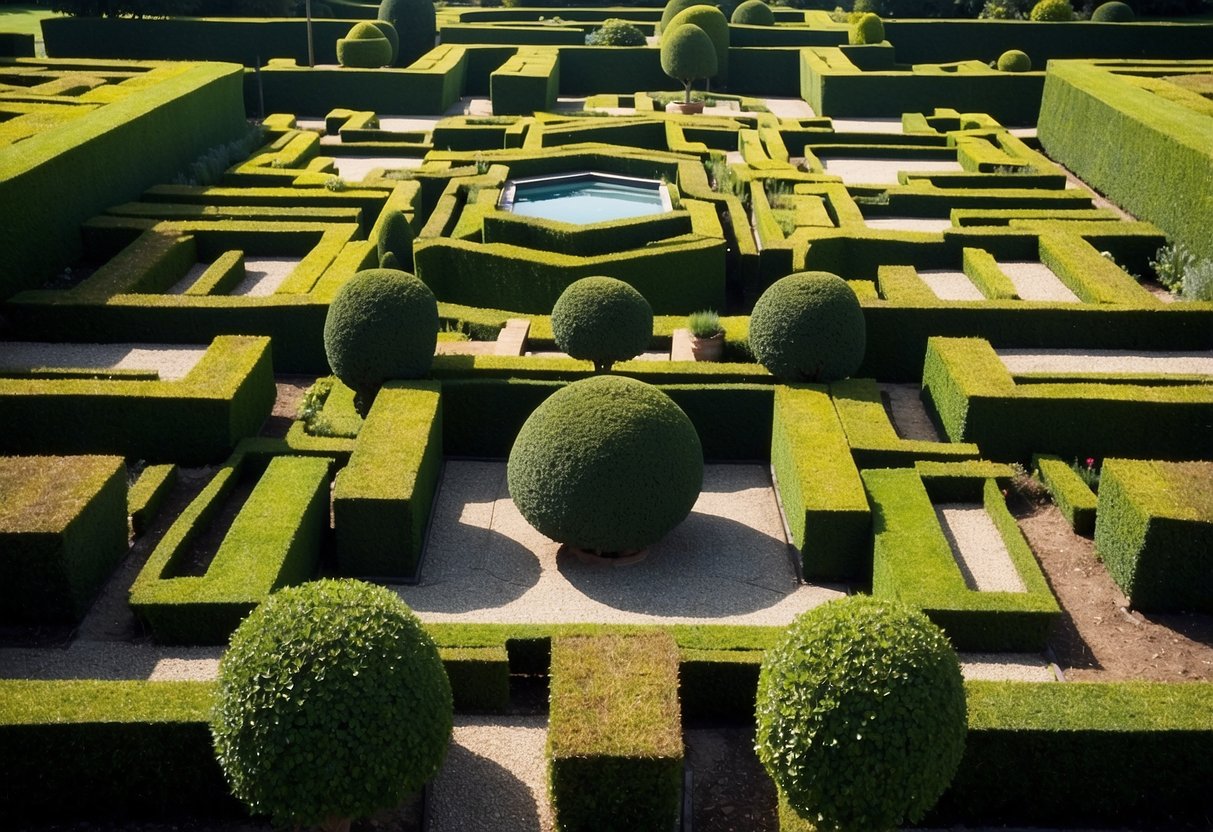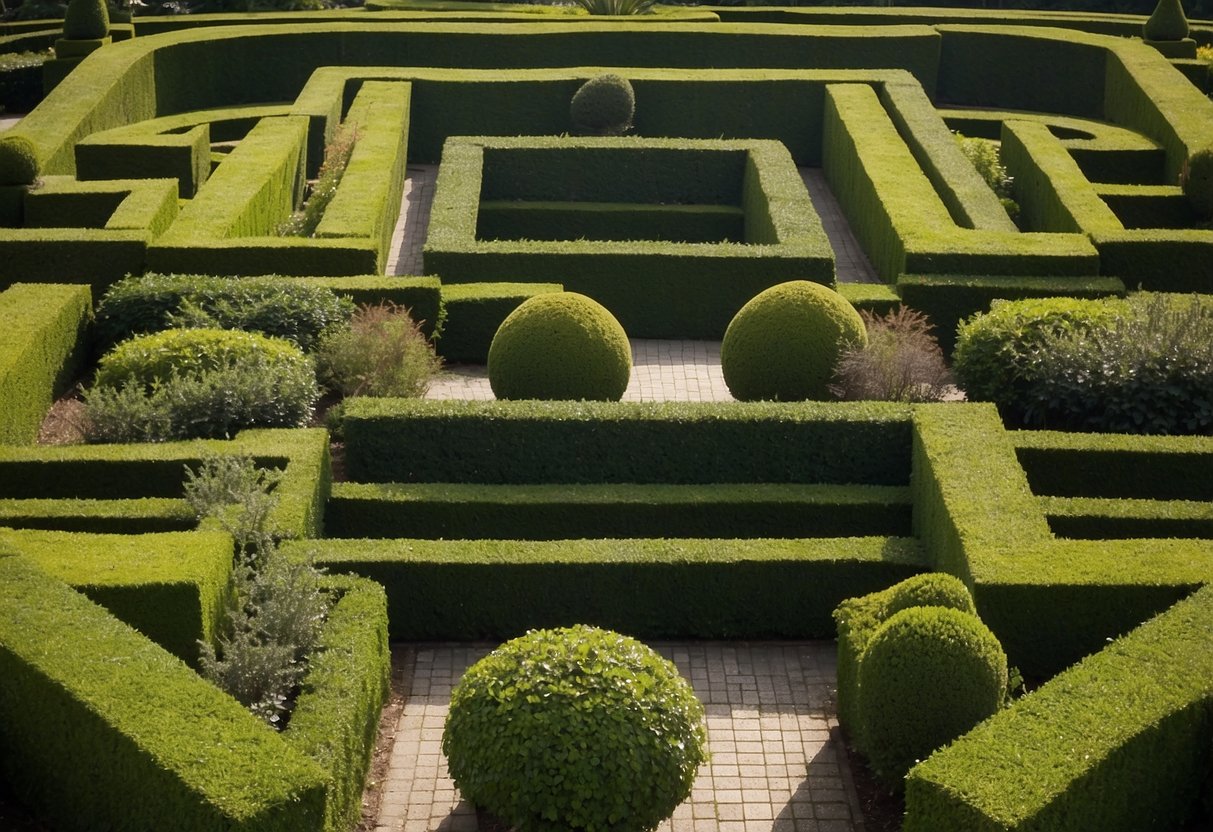Garden Ideas with Box Hedge: Creative Designs for Your Backyard
Creating a beautiful garden can be a rewarding experience, and box hedges are a great way to enhance your outdoor space. These versatile plants are perfect for adding structure and elegance to your garden, whether you’re working with a small urban plot or a sprawling backyard.

By incorporating box hedges into your garden design, you can create defined borders, charming pathways, and eye-catching features. Whether you’re aiming for a modern, minimalist look or a traditional, lush garden, box hedges offer an array of possibilities to suit your style.
1) Boxwood Parterre

A boxwood parterre can add classic charm to your garden. You might use it to create a beautiful and organized pattern in your front yard.
Boxwood hedges are perfect for parterres because they can be shaped into neat designs. These designs can include geometric shapes or even intricate, maze-like patterns.
Adding elements like flowers or a bird bath to the center can complete the look. This setup not only looks good but also brings a touch of elegance to your space.
For more inspiration, visit HGTV’s boxwood designs.
2) Formal Box Hedge Entrance

A formal box hedge entrance adds elegance to any garden. You can frame your walkway with neatly trimmed boxwoods, giving your yard a grand appearance. This classic look is both timeless and stylish.
Pair boxwoods on each side of your door or driveway to create a welcoming feel. The simple, green hedges offer a touch of sophistication.
For low maintenance, light trimming is all you need. This way, your entrance remains sharp and tidy year-round.
3) Boxwood Topiaries

Boxwood topiaries add a touch of elegance and artistry to your garden. They are known for their dense foliage, which makes them perfect for shaping into various forms.
You can create simple shapes like spheres and cones or more intricate designs like animals and spirals. These topiaries can be focal points in your garden or enhance the entryway to your home.
Maintaining topiaries involves regular pruning to keep their shape. Not only do they provide structure, but they also offer year-round greenery. Add boxwood topiaries to showcase your creativity and improve your garden’s appeal.
4) Box Hedge Labyrinth

A box hedge labyrinth can add a fun and elegant element to your garden. With their dense, slow-growing nature, boxwoods create defined paths perfect for a maze.
Designing a labyrinth with box hedges allows you to choose different shapes and patterns. You can opt for a simple circular design or something more intricate.
Box hedge labyrinths offer a unique way to make your garden a place of exploration and tranquility. With regular trimming, they maintain their structure and beauty year-round. Explore how you can add one of these stylish features by checking out some design ideas here.
5) Fragrant Lavender and Box Border

A fragrant lavender and box border is perfect for any garden. The soft purple blooms of lavender offer a pleasant scent and a beautiful contrast to the deep green boxwoods.
Lavender needs full sun and well-drained soil. Boxwoods are easy to shape and trim, providing a neat frame for the lively lavender.
Plant lavender in front of your boxwood hedge to create a stunning, aromatic border. To explore more ideas for combining boxwood and lavender, visit this guide on garden borders with lavender.
6) Mixed Shrub and Box Edging

You can create a beautiful garden border by mixing boxwoods with other shrubs. Boxwoods, with their deep green color, provide a lovely base.
Try using shrubs like thyme and sage. These plants add different textures and colors. This combination keeps your garden interesting all year round.
Finally, consider adding some flowering shrubs. Gardenias and rosemary not only look great but also smell amazing. This mix will make your garden vibrant and welcoming.
7) Geometric Boxwood Patterns

Geometric boxwood patterns can transform your garden into a stunning, formal display. One popular idea is creating a boxwood knot garden, where shrubs are shaped into intricate designs.
These patterns can include squares, circles, and other geometric shapes to add a unique touch. For a modern twist, you can combine different shapes to create an eye-catching layout.
Using boxwoods for these patterns ensures your garden remains green year-round. This idea suits both traditional and contemporary garden styles.
Learn more about boxwood landscaping ideas to inspire your geometric designs.
8) Box Hedge Living Fence

A box hedge living fence can add elegance and structure to your garden. These hedges are not only stylish but also functional, creating natural barriers that are pleasing to the eye.
Boxwoods like the ‘Winter Gem’ are perfect for this purpose. They grow up to 4 feet tall, providing a dense, rounded look ideal for privacy.
This type of living fence can be used to define spaces, like walkways or seating areas, giving your garden a neat and orderly appearance. Plus, they are relatively low-maintenance, making them a practical choice for busy gardeners.
9) Boxwood Knot Garden

Creating a Boxwood Knot Garden adds a touch of elegance and history to your yard. This style involves shaping boxwood shrubs into intricate geometric patterns. The evergreen nature of boxwoods means your design will look fantastic all year round.
Boxwood is a low-maintenance option for knot gardens. Just give them an occasional light trim to keep the shapes crisp. With their dense growth, boxwoods are perfect for creating the detailed lines and curves typical of knot gardens.
Explore more about making a knot garden with boxwood at Instant Hedge.
10) Box Hedge Pathway Lining

Box hedges can create a charming and neat border along your garden pathways. They provide a green, natural edge that makes your walkway look polished.
You can trim the box hedges into rounded shapes for a classic look or keep them squared for a more modern feel. Box hedges also offer a lovely contrast to stone or brick paths.
Boxwood shrubs are low-maintenance, making them a practical choice. Their evergreen nature ensures your pathway looks beautiful year-round. Lining your path with box hedges enhances both functionality and style in your garden.
Benefits of Box Hedge Gardens

Box hedge gardens are popular for their ability to create privacy and security while requiring very little maintenance. Both of these benefits make them a great choice for many homeowners.
Privacy and Security
Box hedge gardens provide an effective means to boost both privacy and security. Their dense foliage can form a thick, natural barrier around your property, keeping prying eyes at bay.
A well-maintained box hedge can deter potential intruders. The natural barrier is not only visually appealing but also functional. This can be especially useful in areas where fencing may not be allowed or desired.
Box hedges can be pruned to any height you need. This versatility allows you to create custom boundaries that fit your specific privacy and security needs. Their evergreen nature ensures year-round protection, unlike seasonal plants that may lose leaves in winter.
Low Maintenance
Box hedge gardens are known for being low maintenance, a key reason they are so popular. These hardy plants do not require frequent watering or fertilization, making them an excellent choice for busy homeowners.
Pruning is simple and uncomplicated. Box hedges can hold their shape well, and periodic trimming is often enough to keep them looking neat.
Boxwoods are generally resistant to pests and diseases. This resilience means you are less likely to encounter issues that require intensive care or treatments. Plus, they can thrive in a variety of soil types and weather conditions, reducing the need for special soil amendments or climate considerations.
Pairing boxwood with other low-maintenance plants can create a beautiful yet easy-to-care-for landscape.
Designing Your Box Hedge Garden

To create a beautiful and functional box hedge garden, you need to select the right variety of boxwoods and carefully plan their layout.
Choosing the Right Variety
Selecting the appropriate boxwood variety is crucial. Different types of boxwoods have varying growth patterns, sizes, and colors. Some popular options include:
- English Boxwood (Buxus sempervirens
Suffruticosa): Known for its compact size and fine-textured leaves, it’s perfect for low hedges. - American Boxwood (Buxus sempervirens): Grows taller and is suitable for more substantial hedges or topiaries.
- Japanese Boxwood (Buxus microphylla var. japonica): Tolerates heat better and is good for regions with hot summers.
Think about your garden’s climate, space, and your desired hedge height. If you need low borders, English boxwood is ideal. For taller privacy hedges, American boxwood might be a better fit. Make sure to consider maintenance needs and disease resistance as well.
Planning the Layout
Start by measuring the area where you want to plant the box hedge. Sketch a map of your garden to visualize the design.
- Pathways and Borders: Use boxwoods to define walkways or borders. Plant them in single rows for a clean look or double rows for a thicker hedge.
- Shape and Spacing: Decide whether you want straight lines, curves, or geometric shapes. Keep in mind that spacing affects density; 12-15 inches between plants is good for a dense hedge.
- Companion Plants: Pair boxwoods with colorful perennials or ornamental grasses to add visual interest. Think about seasonal changes and how companions will contrast or complement your boxwoods.
Proper planning helps ensure your garden looks well-organized and remains easy to maintain. Keeping variety, spacing, and companion plants in mind will make your box hedge garden both beautiful and practical.
Caring for Your Box Hedge

Proper care for your box hedge is essential to keep it healthy and looking great. Focus on the right watering, fertilizing, and pruning techniques to ensure a lush and vibrant hedge.
Watering and Fertilizing
Box hedges need consistent moisture but don’t like soggy soil. It’s important to water them regularly, especially during dry periods. Water deeply to encourage roots to grow downwards. A good rule is to water once a week, increasing the frequency during hot weather.
Fertilizing is equally crucial. Use a balanced fertilizer in early spring. An example is a 10-10-10 mix. Apply it again in mid-summer to promote healthy growth. Be careful not to over-fertilize, as it can damage the plants.
Mulching helps retain moisture and keeps weeds at bay. Apply a layer of organic mulch around the base. This keeps the soil temperature stable and reduces water evaporation.
Pruning Techniques
Pruning helps maintain the shape and health of your box hedge. Prune it twice a year, ideally in late spring and early fall. Early pruning allows for new growth, while fall pruning prepares it for winter.
Always use sharp, clean shears to make clean cuts. This helps prevent disease. Remove any dead or damaged branches first. Then, trim the sides and top to your desired shape.
Tip: Cutting just above a node encourages new growth. Be gentle and avoid cutting too much at once. This keeps the hedge from becoming overly stressed.
With consistent care, your box hedge will thrive, providing a beautiful and functional addition to your garden.







